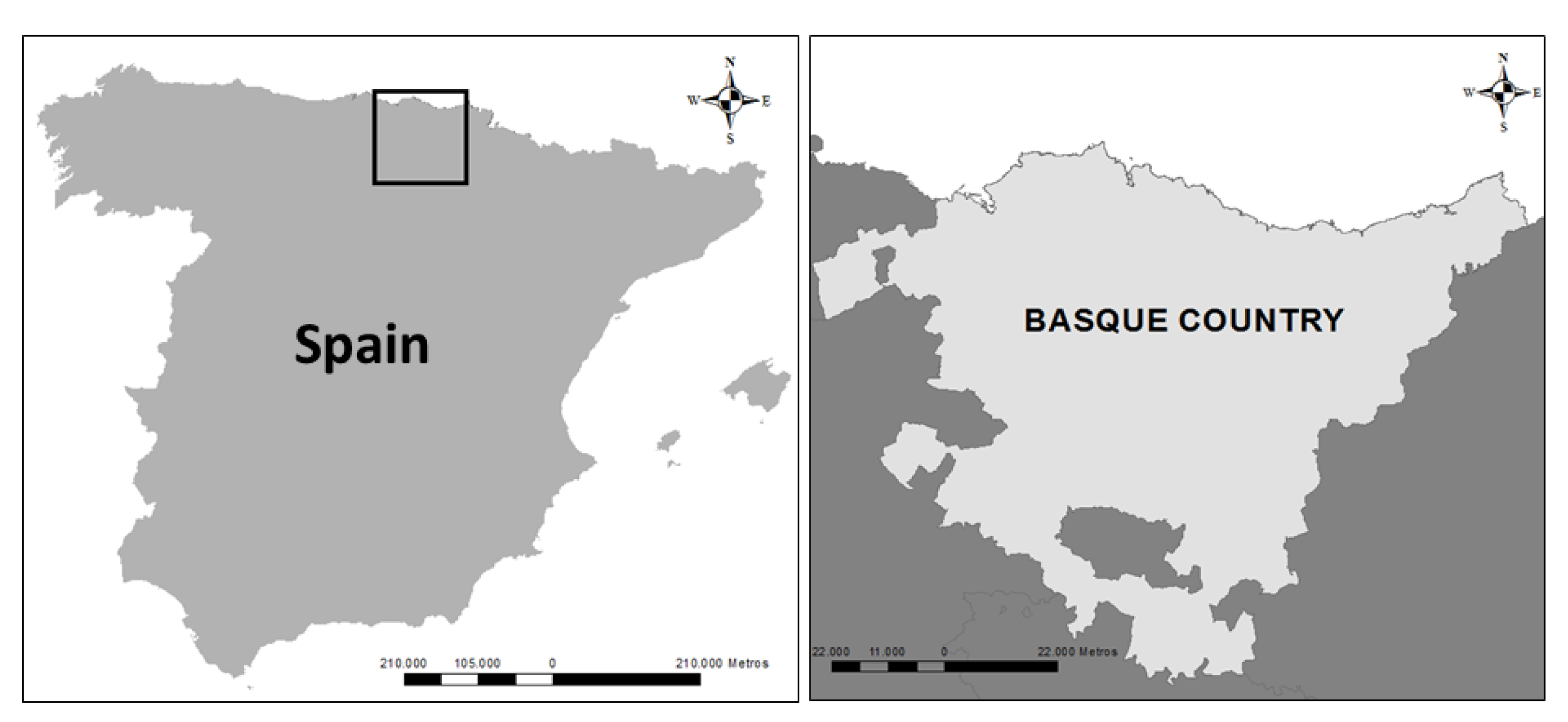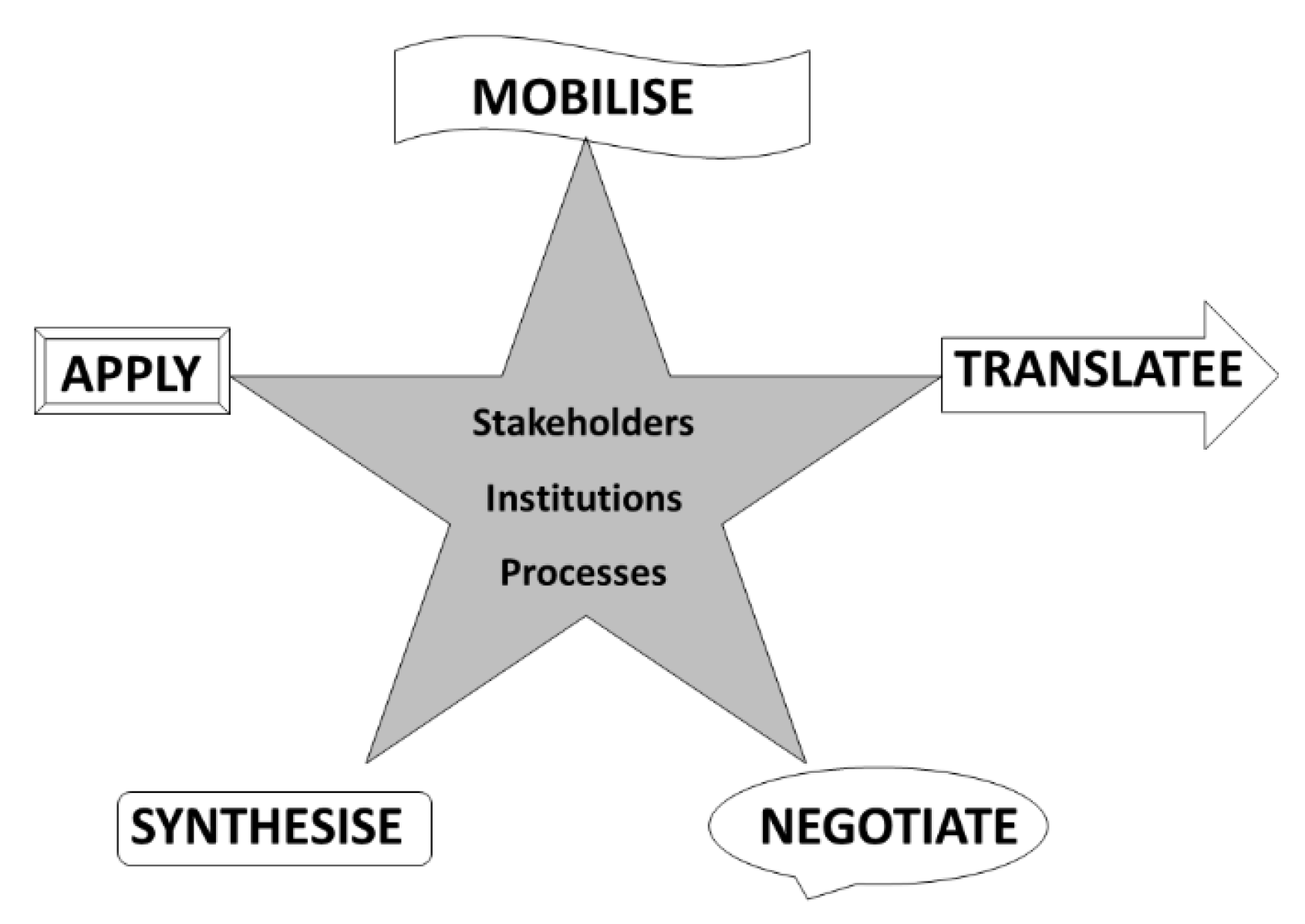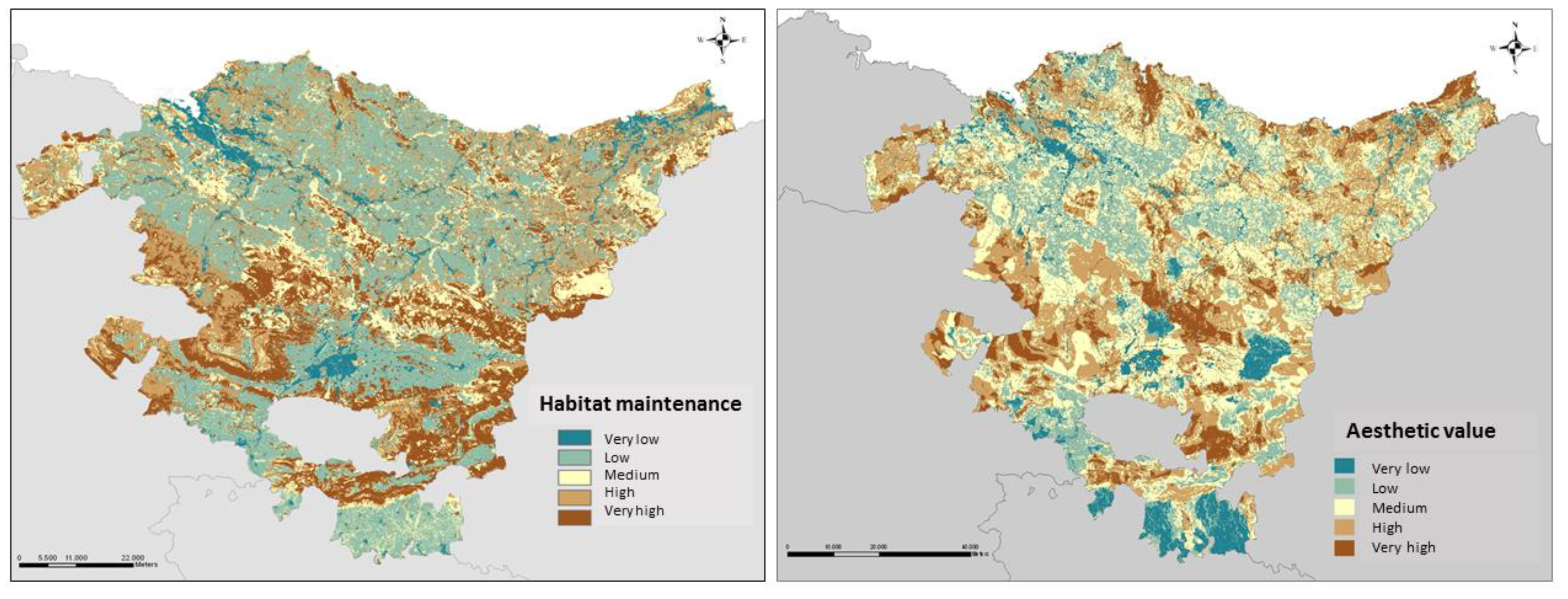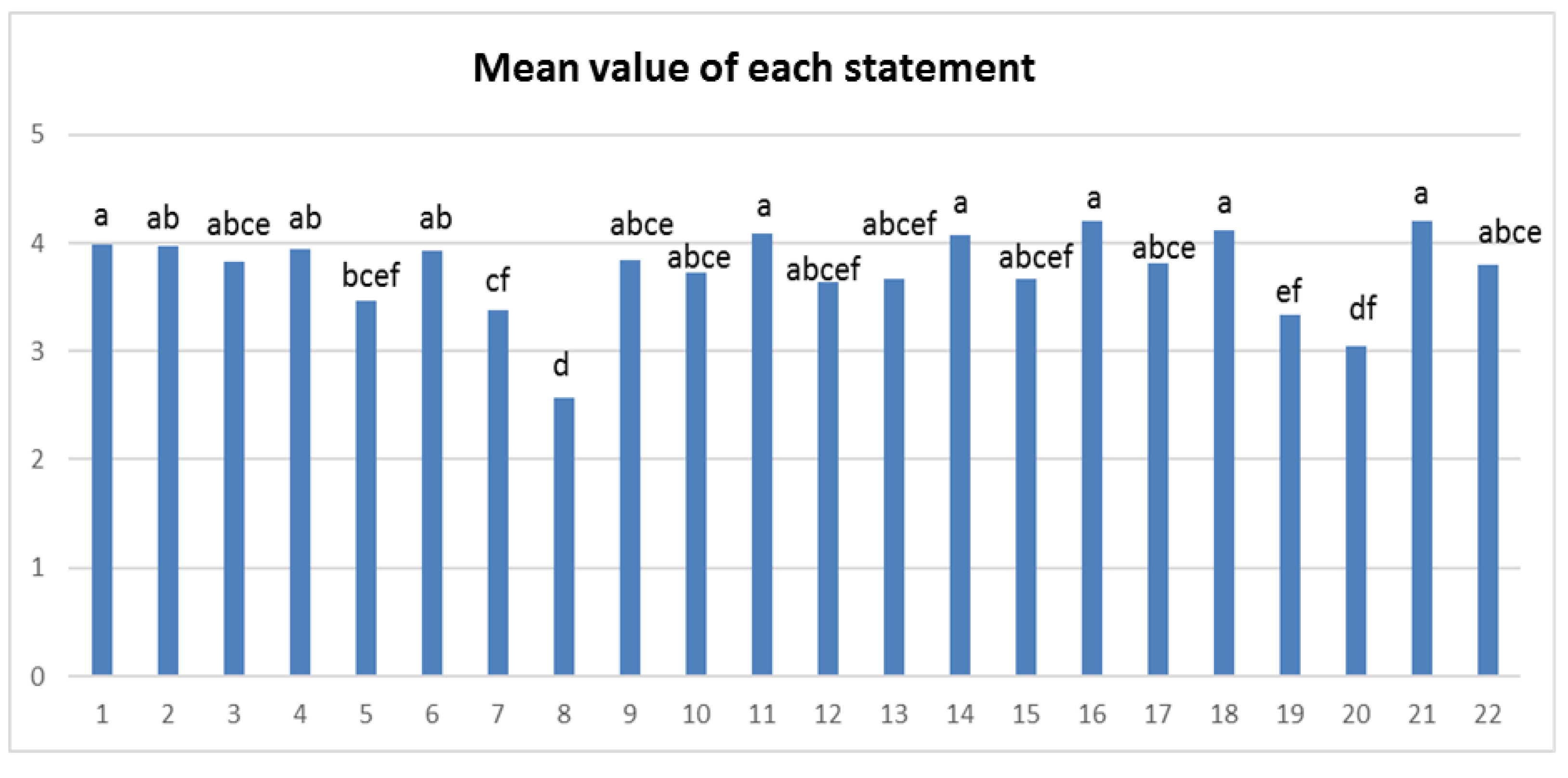Co-Creation of Knowledge for Ecosystem Services Approach to Spatial Planning in the Basque Country
Abstract
1. Introduction
2. Materials and Methods
2.1. Study Area
2.2. Creation of a Community of Practice for Implementing the ESA in Spatial Planning
2.3. Knowledge Co-Creation Process Assessment
2.4. Proposal for a Regional Green Infrastructure Using the ESA
3. Results
3.1. Outcomes of Knowledge Co-Creation Process
3.2. Application of Knowledge Co-Creation Outcomes
3.3. SWOT Analysis of the Knowledge Co-Creation Process
4. Discussion
4.1. A New Approach to Sustainable Spatial Planning
4.2. Lesson Learned: Challenges for Policy Implementation and Key Success Factors
4.3. A New Paradigm for Science: Sustainability
5. Conclusions
Author Contributions
Funding
Acknowledgments
Conflicts of Interest
Appendix A. Overview of the Activities Carried out by the Community of Practice
| YEAR | COMMUNITY OF PRACTICE STAKEHOLDERS | MEETINGS/WORKSHOPS (NUM. PEOPLE) |
| 2013 | Regional Basque Government:
University of the Basque Country (UPV/EHU): 7 scientists UNESCO Etxea-Basque UNESCO centre: 3 technical experts | Technical, scientific and political workshop: 27 June:
|
| 2014 | Regional Basque Government:
Local councils and sub-provincial associations:
Regional Basque Government: IHOBE: 4 technical experts Ingurugela: 1 technical expert UNESCO Etxea-Basque UNESCO centre: 2 technical experts | Technical, scientific and political workshops:
|
| 2015 | Regional Basque Government:
University of the Basque Country (UPV/EHU): 4 scientists UNESCO Etxea-Basque UNESCO centre: 2 technical experts | Workshop with technical experts, scientists and politicians:
|
| 2016 | Regional Basque Government:
UNESCO Etxea-Basque UNESCO centre: 2 technical experts | Meetings between technical experts and scientists:
|
| 2017 | Regional Basque Government:
UNESCO Etxea-Basque UNESCO centre: 1 technical expert | Meetings between technical experts and scientists:
|
| 2018 | Regional Basque Government:
UNESCO Etxea-Basque UNESCO centre: 1 technical expert | Workshop with technical experts, scientists and politicians:
|
| 2019 | Regional Basque Government:
UNESCO Etxea-Basque UNESCO centre: 1 technical expert | Meetings between technical experts and scientists:
|
Appendix B. Statements about the Integration of ES into Spatial Planning Extracted from the SWOT Matrix and Assessed Through an Online Survey
- The use of methodologies linked to ecosystem services is an opportunity to recover biodiversity.
- The support of international organisations and environmental regulation bodies contributes to the integration of ecosystem services into landscape management.
- The conceptual framework of ecosystem services offers a comprehensive view of the region and facilitates optimal management of it.
- Ecosystem services help assess environmental problems and how they can be compensated for.
- The conceptual framework of ecosystem services establishes synergies between public administrations and social stakeholders.
- There is little funding available for issues linked to ecosystem services.
- There is a long history of processing environmental information, which may help facilitate the application of ecosystem services in landscape management.
- It is a concept that the public finds familiar and easy to understand. The language is easy to understand for both the public and decision-makers.
- There is a lack of practical instruments for implementing ecosystem services in landscape management, which makes it hard to do in day-to-day management.
- Methodologies linked to ecosystem services strengthen nature-based solutions.
- The lack of, or failure to comply with, international agreements may weaken the integration of ecosystem services into landscape management.
- The conceptual framework of ecosystem services is increasingly present in international regulations and documents.
- The application of ecosystem services in landscape management helps foster R&D.
- Lack of knowledge regarding the methods used may generate mistrust in its working.
- The existence of an increasing number of very active citizen platforms may facilitate the application of the ecosystem services outlook in landscape management.
- Budgetary cutbacks may hamper the integration of ecosystem services into landscape management.
- Processes such as globalisation and migrations from rural areas to cities result in a decrease in the public perception of environmental values.
- Ecosystem services generate knowledge, which encourages people to attach greater value to the environment.
- The use of ecosystem services in landscape management may cause people to overlook the intrinsic value of natural diversity.
- It is difficult to adapt the concept of ecosystem services to the public discourse.
- Ecosystem services are not a priority on the political agenda, due to a lack of awareness among political and economic authorities.
- The language used in relation to ecosystem services is hard to understand, with an overly anthropocentric focus.
References
- Steffen, W.; Grinevald, J.; Crutzen, P.; McNeill, J. The Anthropocene: Conceptual and historical perspectives. Philos. Trans. R. Soc. A Math. Phys. Eng. Sci. 2011, 369, 842–867. [Google Scholar] [CrossRef] [PubMed]
- Duarte, C.M.; Alonso, S.; Benito, G.; Dachs, J.; Montes, C.; Pardo Buendía, M.; Ríos, A.F.; Simó, R.; Valladares, F. Cambio Global. Impacto de la Actividad Humana Sobre el Sistema Tierra; Colección divulgación 3: Madrid, Spain, 2006; p. 167. ISBN 978-84-00-08452-3. [Google Scholar]
- Reyers, B.; Folke, C.; Moore, M.-L.; Biggs, R.; Galaz, V. Social-Ecological Systems Insights for Navigating the Dynamics of the Anthropocene. Annu. Rev. Environ. Resour. 2018, 43, 267–289. [Google Scholar] [CrossRef]
- Wu, J. Landscape sustainability science: Ecosystem services and human well-being in changing landscapes. Landsc. Ecol. 2013, 28, 999–1023. [Google Scholar] [CrossRef]
- Costanza, R.; D’Arge, R.; De Groot, R.; Farber, S.; Grasso, M.; Hannon, B.; Limburg, K.; Naeem, S.; O’Neill, R.V.; Paruelo, J.; et al. The value of the world’s ecosystem services and natural capital. Nature 1997, 387, 253–260. [Google Scholar] [CrossRef]
- MEA (Millenium Ecosystem Assessment). Ecosystem and Human Well-Being: Synthesis; Island Press: Washington, DC, USA, 2005. [Google Scholar]
- Díaz, S.; Pascual, U.; Stenseke, M.; Martín-López, B.; Watson, R.T.; Molnár, Z.; Hill, R.; Chan, K.M.A.; Baste, I.A.; A Brauman, K.; et al. Assessing nature’s contributions to people. Science 2018, 359, 270–272. [Google Scholar] [CrossRef]
- Jorda-Capdevila, D.; Glenk, K.; Holstead, K. What defines ecosystem services-based approaches? In Water Ecosystem Services; Cambridge University Press (CUP): Cambridge, UK, 2015; pp. 3–14. [Google Scholar]
- Beaumont, N.J.; Mongruel, R.; Hooper, T. Practical application of the Ecosystem Service Approach (ESA): Lessons learned and recommendations for the future. Int. J. Biodivers. Sci. Ecosyst. Serv. Manag. 2017, 13, 68–78. [Google Scholar] [CrossRef]
- Reyers, B.; Nel, J.L.; O’Farrell, P.J.; Sitas, N.; Nel, D.C. Navigating complexity through knowledge coproduction: Mainstreaming ecosystem services into disaster risk reduction. Proc. Natl Acad. Sci. USA 2015, 112, 7362–7368. [Google Scholar] [CrossRef]
- Carmen, E.; Watt, A.; Carvalho, L.; Dick, J.; Fazey, I.; Garcia-Blanco, G.; Grizzetti, B.; Hauck, J.; Izakovicova, Z.; Kopperoinen, L.; et al. Knowledge needs for the operationalisation of the concept of ecosystem services. Ecosyst. Serv. 2018, 29, 441–451. [Google Scholar] [CrossRef]
- European Commission. European Commission Communication from the Commission to the European Parliament; The Council, the European Economic and Social Committee and the Committee of the Regions: Green Infrastructure (GI)—Enhancing Europe’s Natural Capital; European Commission: Brussels, Belgium, 2013. [Google Scholar]
- Naumann, S.; McKenna, D.; Kaphengst, T.; Pieterse, M.; Rayment, M.D. Implementation and Cost Elements of Green Infrastructure Projects; Final report to the European Commission: Brussels, Belgium, 2011. [Google Scholar]
- Davies, C.; Hansen, R.; Rall, E.; Pauleit, S.; Lafortezza, R.; De Bellis, Y.; Santos, A.; Tosics, I. Green Infrastructure Planning and Implementation—The Status of European Green Space Planning and Implementation Based on an Analysis of Selected European City-Regions. EU FP7 Project GREEN SURGE (ENV.2013.6.2-5-603567), Deliverable 5.1, 2015. Available online: https://greensurge.eu/working-packages/wp5/files (accessed on 23 February 2020).
- Schneider, F.; Giger, M.; Harari, N.; Moser, S.; Oberlack, C.; Providoli, I.; Schmid, L.; Tribaldos, T.; Zimmermann, A. Transdisciplinary co-production of knowledge and sustainability transformations: Three generic mechanisms of impact generation. Environ. Sci. Policy 2019, 102, 26–35. [Google Scholar] [CrossRef]
- Schneider, F.; Fry, P.; Ledermann, T.; Rist, S. Social Learning Processes in Swiss Soil Protection—The “From Farmer—To Farmer” Project. Hum. Ecol. 2009, 37, 475–489. [Google Scholar] [CrossRef]
- Wenger, E. Communities of Practice and Social Learning Systems. Organization 2000, 7, 225–246. [Google Scholar] [CrossRef]
- Pahl-Wostl, C.; Craps, M.; Dewulf, A.; Mostert, E.; Tabara, D.; Taillieu, T. Social Learning and Water Resources Management. Ecol. Soc. 2007, 12, 5. [Google Scholar] [CrossRef]
- Hegger, D.; Lamers, M.; Van Zeijl-Rozema, A.; Dieperink, C. Conceptualising joint knowledge production in regional climate change adaptation projects: Success conditions and levers for action. Environ. Sci. Policy 2012, 18, 52–65. [Google Scholar] [CrossRef]
- Schusler, T.M.; Decker, D.J.; Pfeffer, M.J. Social learning for collaborative natural resource management. Soc. Nat. Resour. 2003, 15, 309–326. [Google Scholar] [CrossRef]
- Medema, W.; Adamowski, J.; Orr, C.; Furber, A.; Wals, A.; Milot, N. Building a Foundation for Knowledge Co-Creation in Collaborative Water Governance: Dimensions of Stakeholder Networks Facilitated through Bridging Organizations. Water 2017, 9, 60. [Google Scholar] [CrossRef]
- Cortinovis, C.; Geneletti, D. Ecosystem services in urban plans: What is there, and what is still needed for better decisions. Land Use Policy 2018, 70, 298–312. [Google Scholar] [CrossRef]
- Rozas, D.; Fürst, C.; Geneletti, D.; Almendra, O. Integration of ecosystem services in strategic environmental assessment across spatial planning scales. Land Use Policy 2018, 71, 303–310. [Google Scholar] [CrossRef]
- Basque Government. Habitat EUNIS Map. Available online: ftp://ftp.geo.euskadi.net/cartografia/ (accessed on 20 September 2019).
- Palacios-Agúndez, I.; Fernández De Manuel, B.; Rodríguez-Loinaz, G.; Peña, L.; Ametzaga-Arregi, I.; Alday, J.G.; Casado-Arzuaga, I.; Madariaga, I.; Arana, X.; Onaindia, M. Integrating stakeholders’ demands and scientific knowledge on ecosystem services in landscape planning. Landsc. Ecol. 2014, 29, 1423–1433. [Google Scholar] [CrossRef]
- Palacios-Agúndez, I.; Peña, L.; Ametzaga, I.; Rodríguez-Loinaz, G.; Onaindia, M. Sustainable landscape management based on cultural ecosystem services. Chang. Adapt. Socio-Ecol. Syst. 2017, 3, 103–110. [Google Scholar] [CrossRef]
- Tengö, M.; Hill, R.; Malmer, P.; Raymond, C.M.; Spierenburg, M.; Danielsen, F.; Elmqvist, T.; Folke, C. Weaving knowledge systems in IPBES, CBD and beyond—Lessons learned for sustainability. Curr. Opin. Environ. Sustain. 2017, 26, 17–25. [Google Scholar] [CrossRef]
- Liquete, C.; Kleeschulte, S.; Dige, G.; Maes, J.; Grizzetti, B.; Olah, B.; Zulian, G. Mapping green infrastructure based on ecosystem services and ecological networks: A Pan-European case study. Environ. Sci. Policy 2015, 54, 268–280. [Google Scholar] [CrossRef]
- Onaindia, M.; Peña, L.; Fernández De Manuel, B.; Rodríguez-Loinaz, G.; Madariaga, I.; Palacios-Agúndez, I.; Ametzaga-Arregi, I. Land use efficiency through analysis of agrological capacity and ecosystem services in an industrialized region (Biscay, Spain). Land Use Policy 2018, 78, 650–661. [Google Scholar] [CrossRef]
- Peña, L.; Onaindia, M.; Fernández De Manuel, B.; Ametzaga-Arregi, I.; Casado-Arzuaga, I. Analysing the Synergies and Trade-offs between Ecosystem Services to Reorient Land Use Planning in Metropolitan Bilbao (Northern Spain). Sustainability 2018, 10, 4376. [Google Scholar] [CrossRef]
- Rodríguez-Loinaz, G.; Peña, L.; Palacios-Agúndez, I.; Ametzaga, I.; Onaindia, M.; Ametzaga-Arregi, I. Identifying Green Infrastructure as a Basis for an Incentive Mechanism at the Municipality Level in Biscay (Basque Country). Forests 2018, 9, 22. [Google Scholar] [CrossRef]
- ESRI. ArcMap 10.3. Redlands; Environmental Systems Research Institute: Redlands, CA, USA, 2016. [Google Scholar]
- Reyers, B.; O’Farrell, P.J.; Cowling, R.M.; Egoh, B.N.; Le Maitre, D.C.; Vlok, J.H.J. Ecosystem Services, Land-Cover Change, and Stakeholders: Finding a Sustainable Foothold for a Semiarid Biodiversity Hotspot. Ecol. Soc. 2009, 14, 38. [Google Scholar] [CrossRef]
- O’Farrell, P.J.; Reyers, B.; Le Maitre, D.C.; Milton, S.; Egoh, B.; Maherry, A.; Colvin, C.; Atkinson, D.; De Lange, W.; Blignaut, J.; et al. Multi-functional landscapes in semi arid environments: Implications for biodiversity and ecosystem services. Landsc. Ecol. 2010, 25, 1231–1246. [Google Scholar] [CrossRef]
- Rodríguez-Loinaz, G.; Alday, J.G.; Onaindia, M. Multiple ecosystem services landscape index: A tool for multifunctional landscapes conservation. J. Environ. Manag. 2015, 147, 152–163. [Google Scholar] [CrossRef]
- UNESCO Chair on Sustainable Development and Environmental Education (UPV/EHU). Available online: http://www.ehu.eus/cdsea/web/index.php/investigacion/servicios-ecosistema-euskadi/objetivos/ (accessed on 20 January 2020).
- Eusko Jaurlaritza/Gobierno Vasco. geoEuskadi. Available online: https://www.geo.euskadi.eus/s69-bisorea/es/x72aGeoeuskadiWAR/index.jsp;ftp://ftp.geo.euskadi.eus/cartografia/Medio_Ambiente/Servicios_Ecosistemas/ (accessed on 20 January 2020).
- Castillo-Eguskitza, N.; Martín-López, B.; Onaindia, M. A comprehensive assessment of ecosystem services: Integrating supply, demand and interest in the Urdaibai Biosphere Reserve. Ecol. Indic. 2018, 93, 1176–1189. [Google Scholar] [CrossRef]
- Onaindia, M.; Fernández De Manuel, B.; Madariaga, I.; Rodríguez-Loinaz, G. Co-benefits and trade-offs between biodiversity, carbon storage and water flow regulation. For. Ecol. Manag. 2013, 289, 1–9. [Google Scholar] [CrossRef]
- Eusko Jaurlaritza/Gobierno Vasco. Available online: https://www.euskadi.eus/documentacion/2016/plan-rector-de-uso-y-gestion-prug-de-la-reserva-de-la-biosfera-de-urdaibai/web01-a2ingurd/es/ (accessed on 12 December 2019).
- Bizkaiko Foru Aldundia/Diputación Foral de Bizkaia. Available online: https://www.bizkaia.eus/home2/Temas/DetalleTema.asp?Tem_Codigo=10554&Idioma=CA&dpto_biz=6&codpath_biz=6%7C8366%7C10128%7C10133%7C10131%7C10532 (accessed on 12 December 2019).
- Eusko Jaurlaritza/Gobierno Vasco. Available online: https://www.euskadi.eus/directrices-de-ordenacion-territorial-dot/web01-a2lurral/es/ (accessed on 12 December 2019).
- Burkhard, B.; Maes, J. Mapping Ecosystem Services; Pensoft Publishers: Sofia, Bulgaria, 2017; p. 374. ISBN 978-954-642-829-5. [Google Scholar]
- Fürst, C.; Luque, S.; Geneletti, D. Nexus thinking—How ecosystem services can contribute to enhancing the cross-scale and cross-sectoral coherence between land use, spatial planning and policy-making. Int. J. Biodivers. Sci. Ecosyst. Serv. Manag. 2017, 13, 412–421. [Google Scholar] [CrossRef][Green Version]
- Spyra, M.; Kleemann, J.; Cetin, N.I.; Navarrete, C.J.V.; Albert, C.; Palacios-Agúndez, I.; Ametzaga-Arregi, I.; La Rosa, D.; Rozas-Vásquez, D.; Esmail, B.A.; et al. The ecosystem services concept: A new Esperanto to facilitate participatory planning processes? Landsc. Ecol. 2018, 34, 1715–1735. [Google Scholar] [CrossRef]
- Barbati, A.; Corona, P.; Salvati, L.; Gasparella, L. Natural forest expansion into suburban countryside: Gained ground for a green infrastructure? Urban For. Urban Green. 2013, 12, 36–43. [Google Scholar] [CrossRef]
- Rozas-Vásquez, D.; Fürst, C.; Geneletti, D.; Muñoz, F. Multi-actor involvement for integrating ecosystem services in strategic environmental assessment of spatial plans. Environ. Impact Assess. Rev. 2017, 62, 135–146. [Google Scholar] [CrossRef]
- Díaz, S.; Demissew, S.; Carabias, J.; Joly, C.; Lonsdale, M.; Ash, N.; Larigauderie, A.; Adhikari, J.R.; Aricò, S.; Báldi, A.; et al. The IPBES Conceptual Framework—Connecting nature and people. Curr. Opin. Environ. Sustain. 2015, 14, 1–16. [Google Scholar] [CrossRef]
- Galvin, K.A.; Reid, R.S.; E Fernández-Giménez, M.; Kaelo, D.O.; Baival, B.; Krebs, M. Co-design of transformative research for rangeland sustainability. Curr. Opin. Environ. Sustain. 2016, 20, 8–14. [Google Scholar] [CrossRef]
- Pascual, U.; Balvanera, P.; Díaz, S.; Pataki, G.; Roth, E.; Stenseke, M.; Watson, R.T.; Dessane, E.B.; Islar, M.; Kelemen, E.; et al. Valuing nature’s contributions to people: The IPBES approach. Curr. Opin. Environ. Sustain. 2017, 26, 7–16. [Google Scholar] [CrossRef]
- Deal, R.; Fong, L.; Phelps, E. Integrating Ecosystem Services into National Forest Service Policy and Operations; Gen. Tech. Rep. PNW-GTR-943; US Department of Agriculture, Forest Service, Pacific Northwest Research Station: Portland, OR, USA, 2017; Volume 87, p. 943.
- Harrison-Atlas, D.; Theobald, D.M.; Goldstein, J.H. A systematic review of approaches to quantify hydrologic ecosystem services to inform decision-making. Int. J. Biodivers. Sci. Ecosyst. Serv. Manag. 2016, 12, 160–171. [Google Scholar] [CrossRef]
- Başkent, E.Z. A Framework for Characterizing and Regulating Ecosystem Services in a Management Planning Context. Forests 2020, 11, 102. [Google Scholar] [CrossRef]
- Kates, R.W. From the Unity of Nature to Sustainability Science: Ideas and Practice; Center for International Development Working; Harvard University: Cambridge, MA, UK, 2011; p. 218. [Google Scholar]
- Bettencourt, L.M.A.; Kaur, J. Evolution and structure of sustainability science. Proc. Natl. Acad. Sci. USA 2011, 108, 19540–19545. [Google Scholar] [CrossRef]
- Miller, T.R.; Wiek, A.; Sarewitz, D.; Robinson, J.; Olsson, L.; Kriebel, D.; Loorbach, D. The future of sustainability science: A solutions-oriented research agenda. Sustain. Sci. 2014, 9, 239–246. [Google Scholar] [CrossRef]
- Wiek, A.; Lang, D.J. Transformational Sustainability Research Methodology. In Sustainability Science; Heinrichs, H., Martens, P., Michelsen, G., Wiek, A., Eds.; Springer: Dordrecht, The Netherlands, 2016. [Google Scholar]
- Berkes, F.; Folke, C. Linking Social and Ecological Systems. Management Practices and Social Mechanisms for Building Resilience; Cambridge University Press: New York, NY, USA, 1998. [Google Scholar]
- Keeler, B.L.; Chaplin-Kramer, R.; Guerry, A.D.; Addison, P.F.E.; Bettigole, C.; Burke, I.C.; Gentry, B.; Chambliss, L.; Young, C.; Travis, A.J.; et al. Society Is Ready for a New Kind of Science—Is Academia? BioScience 2017, 67, 591–592. [Google Scholar] [CrossRef]






| SERVICES | PROXIES | METHODS |
|---|---|---|
| Food production (agriculture and livestock farming) | Mean human food yield (agriculture (AY) and livestock farming (LFY)) | AY = Mean agricultural yield of crops used to produce food for humans (t/ha) LFY = Mean yield from slaughtered livestock (t/ha) |
| Timber production | Annual growth of timber-producing forest ecosystems | Annual growth (m3year−1ha−1) obtained using LIDAR (Laser Imaging Detection and Ranging) 2008 and 2012, calculated by HAZI |
| Habitat maintenance | Habitat maintenance index | HM = W + S + P HM = Habitat maintenance index W = Native vascular plant species richness S = Successional state P = Protected areas or areas of natural interest |
| Carbon storage | Total carbon (C) content | TC = CLB + CDB + CS TC = Total C content (tC/ha) CLB = C content in live biomass (tC/ha) CDB = C content in dead biomass (tC/ha) CS = TC content in the soil (tC/ha) |
| Air purification | Capacity to eliminate NO2 from the air | CE NO2 = C NO2 * Rd NO2 CE NO2 = Capacity to eliminate NO2 from the air (µg/m2s) C NO2 = Mean annual concentration of NO2 in the air (µg/m3) Rd NO2 = Rate of dry deposition of NO2 in leaves (ms−1) |
| Water flow regulation | Water retention index | WRI = (WRv Rv + WRgw Rgw + WRs Rs + Wslope Slope + WWB RWB) * (1- Ra/100) WRI = Water retention index WRv, WRgw, WRs, Wslope, WWB = Weights assigned to each variable Rv = Retention by vegetation Rgw = Retention in ground water Rs = Retention in soil RWB = Retention in water bodies Ra = Soil waterproofing |
| Pollination | Index of abundance of nesting pollinators | Pollination module from the InVEST program |
| Recreation | Recreation index | R = PR + CR R = Recreation index PR = Potential for recreation CR = Capacity for recreation PR = N + P + A + G + R N = Naturalness index P = Level of protection
R = Presence of summits (mountains) CR = A + I A = Accessibility
|
| Aesthetic value of the landscape | Aesthetic value of the landscape | AL = P + R + La + A + LM - NE AL = Aesthetic landscape index P = Society’s perceptions R = Type of relief La = Diversity of landscapes A = Presence of surface water bodies LM = Influence of natural landmarks NE = Influence of negative elements |
© 2020 by the authors. Licensee MDPI, Basel, Switzerland. This article is an open access article distributed under the terms and conditions of the Creative Commons Attribution (CC BY) license (http://creativecommons.org/licenses/by/4.0/).
Share and Cite
Peña, L.; Fernández de Manuel, B.; Méndez-Fernández, L.; Viota, M.; Ametzaga-Arregi, I.; Onaindia, M. Co-Creation of Knowledge for Ecosystem Services Approach to Spatial Planning in the Basque Country. Sustainability 2020, 12, 5287. https://doi.org/10.3390/su12135287
Peña L, Fernández de Manuel B, Méndez-Fernández L, Viota M, Ametzaga-Arregi I, Onaindia M. Co-Creation of Knowledge for Ecosystem Services Approach to Spatial Planning in the Basque Country. Sustainability. 2020; 12(13):5287. https://doi.org/10.3390/su12135287
Chicago/Turabian StylePeña, Lorena, Beatriz Fernández de Manuel, Leire Méndez-Fernández, María Viota, Ibone Ametzaga-Arregi, and Miren Onaindia. 2020. "Co-Creation of Knowledge for Ecosystem Services Approach to Spatial Planning in the Basque Country" Sustainability 12, no. 13: 5287. https://doi.org/10.3390/su12135287
APA StylePeña, L., Fernández de Manuel, B., Méndez-Fernández, L., Viota, M., Ametzaga-Arregi, I., & Onaindia, M. (2020). Co-Creation of Knowledge for Ecosystem Services Approach to Spatial Planning in the Basque Country. Sustainability, 12(13), 5287. https://doi.org/10.3390/su12135287





